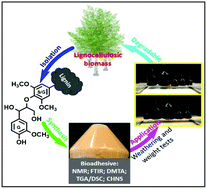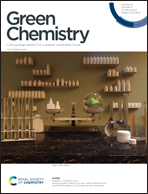Environmentally sustainable, high-performance lignin-derived universal adhesive†
Abstract
The production of unfavorable formaldehyde-based adhesives could be replaced by that of lignin-based adhesives as an improved, healthy and sustainable candidate. Here, a facile method was realized for a novel lignin-based, robust, and universally applicable adhesive (84% yield), based on the synergistic reaction between lignin, dimethylformamide, and acrylic acid under a basic environment. Characterization studies of the synergistically synthesized lignin-based adhesive showed the formation of new C–O, C–N, and C–C bonds. These bonds contributed strongly to excellent adhesive performance on versatile substrates, including glass, aluminum, stainless steel, polycarbonate, polyvinyl chloride, and wood. This universal adhesive was able to hold vertically or horizontally >2.0 × 105 times its own weight for more than 94 d. It also exhibited excellent storage and loss modulus, internal bond strength (255.0 kPa), and physical-mechanical strength under neutral, acidic (pH 3.08) or basic (pH 10.22) media. These advantages enable this lignin-based adhesive to be a universal adhesive in various settings.



 Please wait while we load your content...
Please wait while we load your content...